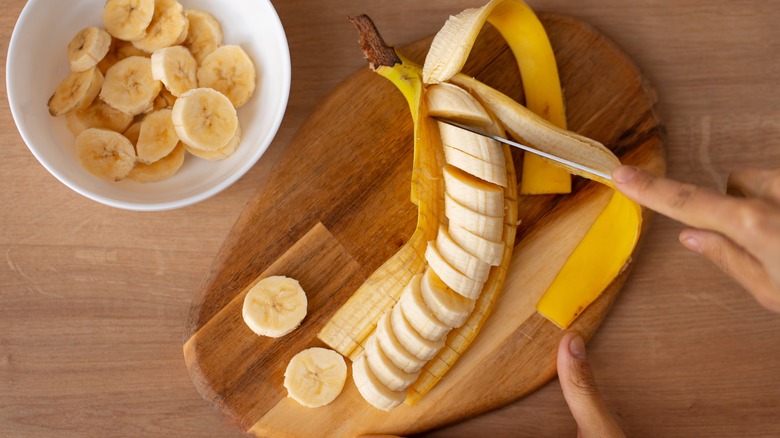Avoid Eating Bananas If You Have This Little-Known Food Intolerance
While some people may enjoy a daily banana, the golden fruit isn't for everybody. No judgment if you're simply just not a fan of the taste, but for people with certain health conditions, such as a food allergy, late-stage kidney failure, or unmanaged diabetes, eating bananas may pose potential health risks, according to Medical News Today. The same is true for individuals with histamine intolerance (HIT), a little-known condition in which a person has high levels of histamine because the body is unable to process the chemical (via Cleveland Clinic).
Histamine serves as a chemical messenger for blood vessel dilation, mucus production, and the tightening of our airways and digestive organs. Naturally produced in the body, this infection-combating chemical is also found in certain food sources. With the condition thought to affect roughly 1 in every 100 people, individuals with a buildup of histamine in the body may experience headaches, diarrhea, rash, itching, low blood pressure, heart arrhythmias, and more. Here's why bananas may further exacerbate the problem.
Bananas are histamine liberators
Tropical fruits, such as papaya, pineapple — and yes, bananas — are known as histamine liberators, as outlined in 2021 research published in the scientific journal Nutrients. These foods prompt the release of histamine from our mast cells, which are white blood cells containing histamine and other chemicals that become activated during an immune system allergic reaction (via the National Cancer Institute). While histamine isn't always found in histamine liberators, consumption of these foods can cause levels of the chemical to rise in the body by prompting an allergic response.
Histamine intolerance has been linked with lower levels of diamine oxidase (DAO) in the body, an enzyme that helps prevent the histamine that we get through our diet from getting reabsorbed into the bloodstream (via Allergologie Select). Without sufficient levels of DAO, the body struggles to break down the chemical. While the cause of histamine intolerance isn't entirely known, people with gene abnormalities, certain gastrointestinal conditions, or kidney or liver diseases may be more susceptible to this little-known food intolerance, reports the Cleveland Clinic. However, logging your meals is one way to help determine whether or not you may have the condition.
What is the low-histamine diet?
In addition to reviewing your food diary, your doctor may also issue certain blood tests or allergy tests to help confirm a diagnosis. While medication may sometimes be prescribed, steering clear of foods known to prompt an allergic reaction is one of the primary treatment methods for histamine intolerance. You might also be advised to stick to a low-histamine diet.
However, researchers from a 2021 research article published in Nutrients point out that what constitutes a high- or low-histamine food isn't always so clear-cut. For example, while some experts are of the opinion that foods containing between 5 and 50 milligrams of histamine per kilogram qualify as low-histamine foods, others feel that less than 1 milligram per kilogram is a better measurement of a low-histamine food. Further complicating things, histamine is not required to be listed on food labels.
Generally speaking, however, the Cleveland Clinic specifically mentions processed meat, cheese, alcohol, chocolate, nuts, peanuts, and bananas as possible triggers, among various other food items. Johns Hopkins Medicine states that quinoa, non-aged fresh meat, non-dairy milk, potatoes, flax, and chia are safer bets. Consult with your doctor if you are concerned about histamine intolerance, and seek urgent medical care if you develop symptoms of a severe allergic reaction, including difficulty breathing, an abrupt decrease in blood pressure, or swelling in the mouth or throat.


